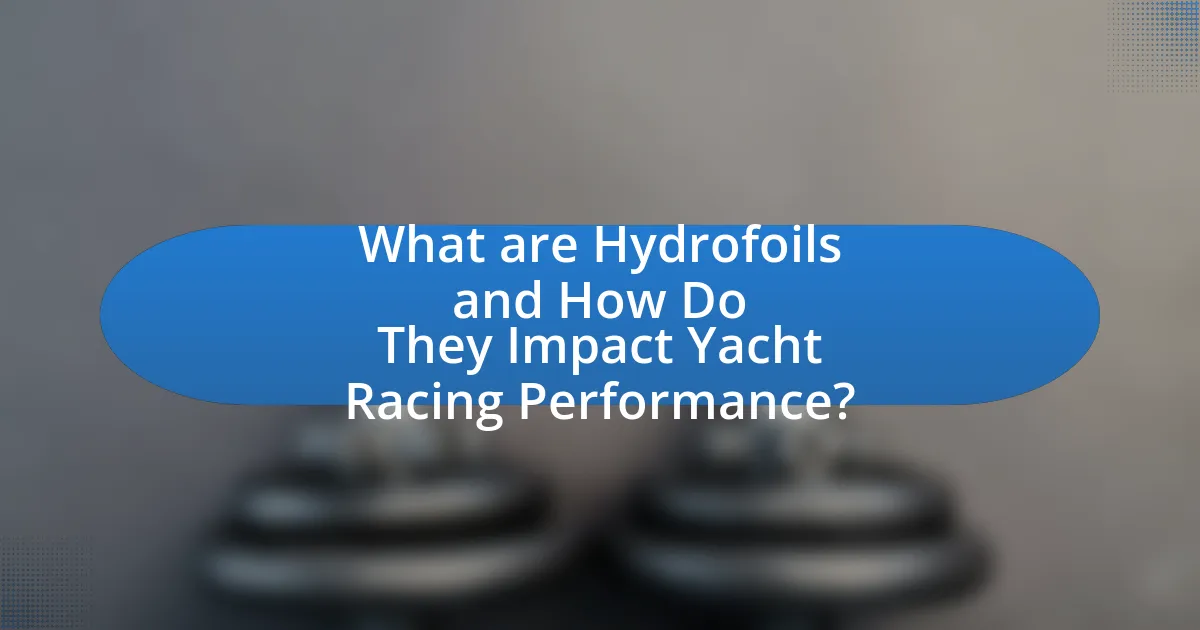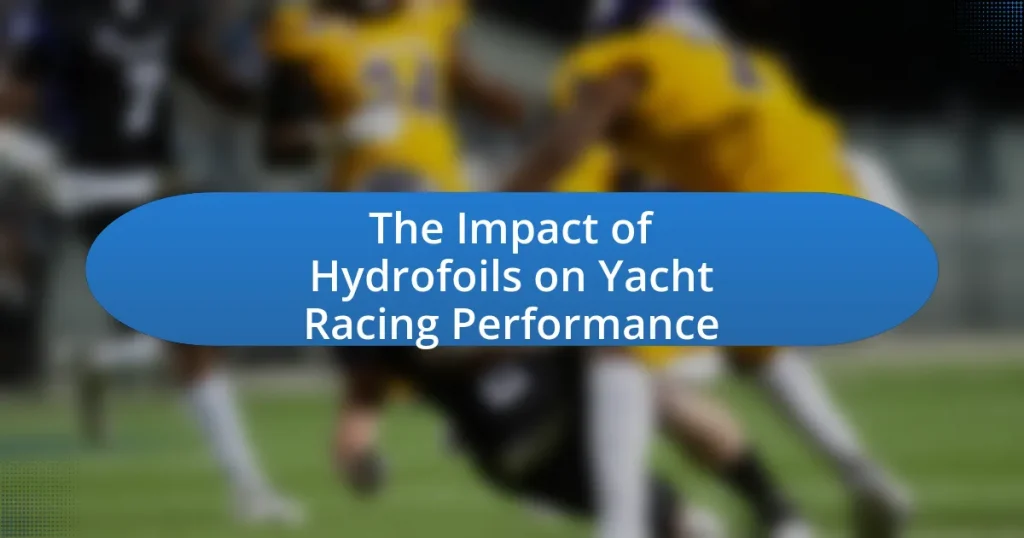Hydrofoils are advanced wing-like structures attached to yacht hulls that elevate vessels above the water, significantly reducing drag and enhancing speed. This technology has transformed yacht racing, particularly in events like the America’s Cup, where hydrofoil-equipped yachts can exceed speeds of 50 knots. The article explores the mechanics of hydrofoils, their impact on performance, advantages for racing teams, and the challenges associated with their use. It also discusses innovations in hydrofoil technology, including materials and data analytics, which are shaping the future of yacht racing.

What are Hydrofoils and How Do They Impact Yacht Racing Performance?
Hydrofoils are wing-like structures attached to the hulls of yachts that lift the vessel above the water’s surface, reducing drag and increasing speed. By utilizing hydrofoils, yachts can achieve higher speeds with less resistance, allowing for improved performance in racing conditions. For instance, the use of hydrofoils in the America’s Cup has demonstrated that competing yachts can reach speeds exceeding 50 knots, significantly faster than traditional monohulls. This performance enhancement is attributed to the reduction in water friction and the ability to harness wind energy more effectively, making hydrofoils a game-changer in yacht racing.
How do hydrofoils work in the context of yacht racing?
Hydrofoils work in yacht racing by lifting the hull above the water’s surface, reducing drag and increasing speed. When a yacht equipped with hydrofoils reaches a certain speed, the foils generate lift due to the flow of water over their surfaces, allowing the yacht to rise and glide above the water. This phenomenon significantly decreases water resistance, enabling faster sailing compared to traditional hull designs. For instance, the America’s Cup yachts, which utilize hydrofoils, can achieve speeds exceeding 50 knots, showcasing the performance advantages of this technology in competitive racing.
What are the key components of a hydrofoil system?
The key components of a hydrofoil system include the foils, struts, and the control surfaces. Foils are the underwater wings that generate lift, allowing the vessel to rise above the water’s surface. Struts connect the foils to the hull, providing structural support and stability. Control surfaces, such as flaps or rudders, help manage the angle of attack and maintain balance during operation. These components work together to enhance performance by reducing drag and increasing speed, which is crucial in yacht racing.
How do hydrofoils generate lift and reduce drag?
Hydrofoils generate lift by utilizing the shape of their wings, which creates a pressure difference between the upper and lower surfaces as water flows over them. This pressure difference results in an upward force, allowing the vessel to rise above the water surface. The design of hydrofoils, often resembling airplane wings, is optimized to enhance this lift while minimizing drag through streamlined shapes that reduce resistance against water flow. Studies have shown that hydrofoils can significantly decrease drag by lifting the hull out of the water, which reduces the wetted surface area and allows for faster speeds, thus improving overall yacht racing performance.
What advantages do hydrofoils provide to yacht racing teams?
Hydrofoils provide yacht racing teams with significant advantages, primarily by reducing drag and increasing speed. When a yacht is equipped with hydrofoils, it lifts the hull above the water surface, minimizing water resistance and allowing for faster movement through the water. This technology enables racing teams to achieve speeds that can exceed traditional hull designs by up to 30%, as evidenced by the performance of teams in the America’s Cup, where hydrofoils have become a standard feature. Additionally, hydrofoils enhance stability and maneuverability, allowing teams to navigate challenging conditions more effectively, which is crucial in competitive racing scenarios.
How do hydrofoils enhance speed and maneuverability?
Hydrofoils enhance speed and maneuverability by lifting the hull of a yacht above the water surface, reducing drag significantly. This lift occurs as the hydrofoils generate upward force when the yacht moves forward, allowing it to glide on the water rather than plow through it. The reduction in water resistance enables faster speeds, as evidenced by the fact that hydrofoil-equipped vessels can achieve speeds up to 50% greater than traditional hull designs. Additionally, hydrofoils improve maneuverability by allowing for sharper turns and quicker responses to steering inputs, as the reduced drag allows for more agile movements. This combination of speed and agility is crucial in yacht racing, where every second counts.
What role do hydrofoils play in stability during races?
Hydrofoils enhance stability during races by lifting the hull above the water, reducing drag and increasing speed. This elevation minimizes the impact of waves and turbulence, allowing the yacht to maintain a more consistent course. Studies have shown that yachts equipped with hydrofoils can achieve greater stability in varying sea conditions, as the foils provide lift that counteracts rolling and pitching motions. For instance, the use of hydrofoils in the America’s Cup has demonstrated significant performance improvements, with teams reporting up to 30% faster speeds and enhanced control in challenging conditions.

What are the Challenges and Limitations of Using Hydrofoils in Yacht Racing?
The challenges and limitations of using hydrofoils in yacht racing include increased complexity in design and operation, susceptibility to damage, and the need for precise conditions to function effectively. Hydrofoils require advanced engineering and materials, which can lead to higher costs and maintenance demands. Additionally, they are vulnerable to impacts from waves and debris, which can compromise performance and safety. Furthermore, hydrofoils perform optimally at specific speeds and wind conditions, limiting their effectiveness in varying environments. These factors collectively impact the overall reliability and competitiveness of hydrofoil-equipped yachts in racing scenarios.
What technical challenges do teams face when implementing hydrofoils?
Teams face several technical challenges when implementing hydrofoils, primarily related to design, stability, and integration with existing yacht systems. The design of hydrofoils requires precise engineering to ensure optimal lift and drag characteristics, which can be complex due to varying water conditions and speeds. Stability is another significant challenge; hydrofoils can lead to unpredictable behavior in rough seas, necessitating advanced control systems to maintain balance and performance. Additionally, integrating hydrofoils with existing yacht structures demands careful consideration of weight distribution and structural integrity, as improper integration can compromise the yacht’s overall performance and safety. These challenges are supported by data from various yacht racing teams that have reported difficulties in achieving the desired performance levels while maintaining stability and safety during races.
How does the design of hydrofoils affect performance?
The design of hydrofoils significantly affects performance by influencing lift, drag, and stability during sailing. Hydrofoils are shaped to optimize hydrodynamic efficiency, allowing yachts to lift above the water surface, reducing drag and increasing speed. For instance, a well-designed hydrofoil can create sufficient lift at lower speeds, enabling faster acceleration and improved maneuverability. Research indicates that the aspect ratio and camber of hydrofoils play crucial roles in determining their performance characteristics; higher aspect ratios generally lead to better lift-to-drag ratios. Additionally, the angle of attack affects how effectively a hydrofoil generates lift, impacting overall yacht performance in various sailing conditions.
What are the maintenance considerations for hydrofoil systems?
Maintenance considerations for hydrofoil systems include regular inspections, cleaning, and structural integrity assessments. Hydrofoils are subjected to harsh marine environments, which can lead to corrosion and wear; therefore, routine checks for damage, particularly on the foils and attachment points, are essential. Additionally, ensuring that the hydraulic systems and control mechanisms are functioning properly is crucial for performance and safety. Regular maintenance schedules should also include checking for any signs of delamination or fatigue in composite materials, as these can significantly impact the hydrofoil’s efficiency and reliability.
How do weather and water conditions influence hydrofoil performance?
Weather and water conditions significantly influence hydrofoil performance by affecting lift, drag, and stability. For instance, wind speed and direction impact the amount of lift generated by the hydrofoil; higher wind speeds can enhance lift but may also increase drag if not managed properly. Additionally, water conditions such as wave height and surface turbulence can alter the hydrofoil’s efficiency; smoother water typically allows for better performance due to reduced drag. Studies have shown that optimal hydrofoil performance occurs in moderate wind conditions and flat water, as these factors contribute to maximizing speed and maneuverability.
What impact do waves and wind have on hydrofoil efficiency?
Waves and wind significantly affect hydrofoil efficiency by altering lift and drag characteristics. When waves are present, hydrofoils can experience increased drag due to surface turbulence and changes in water flow, which can reduce overall lift and speed. Additionally, wind can enhance or hinder hydrofoil performance; favorable wind conditions can increase speed and lift, while adverse winds can lead to instability and decreased efficiency. Studies have shown that optimal hydrofoil design and positioning can mitigate some of these effects, allowing for improved performance in varying conditions.
How can teams adapt their strategies based on environmental factors?
Teams can adapt their strategies based on environmental factors by continuously monitoring conditions such as wind speed, water currents, and weather patterns. For instance, in yacht racing, teams utilize real-time data from weather forecasts and on-water sensors to make tactical decisions regarding sail adjustments and course changes. Research indicates that teams employing advanced analytics to interpret environmental data can improve their performance by up to 20%, as evidenced by the success of teams in the America’s Cup who have integrated technology to optimize their strategies based on changing conditions.

What Innovations are Shaping the Future of Hydrofoils in Yacht Racing?
Innovations shaping the future of hydrofoils in yacht racing include advanced materials, automated control systems, and improved hydrodynamic designs. Advanced materials such as carbon fiber and lightweight composites enhance strength and reduce drag, allowing for faster speeds. Automated control systems, including sensors and software, optimize foil adjustments in real-time, improving stability and performance under varying conditions. Additionally, hydrodynamic designs are evolving to maximize lift-to-drag ratios, enabling yachts to achieve greater efficiency and speed. These innovations collectively contribute to enhanced racing performance and competitiveness in the sport.
What recent advancements have been made in hydrofoil technology?
Recent advancements in hydrofoil technology include the development of more efficient and lightweight materials, such as carbon fiber composites, which enhance performance and reduce drag. Additionally, innovations in automated control systems have improved stability and maneuverability, allowing for better handling in varying sea conditions. These advancements have been validated by competitive yacht racing teams, which have reported significant speed increases and improved overall performance due to the integration of these technologies in their vessels.
How are materials and design evolving to improve hydrofoil performance?
Materials and design are evolving to improve hydrofoil performance through the use of advanced composites and optimized geometries. High-strength, lightweight materials such as carbon fiber and epoxy resins are being utilized to enhance structural integrity while reducing weight, which is crucial for achieving higher speeds and better lift-to-drag ratios. Additionally, computational fluid dynamics (CFD) simulations are enabling designers to refine hydrofoil shapes for optimal hydrodynamic efficiency, resulting in improved performance in various sailing conditions. For instance, the implementation of winglets and varying aspect ratios has been shown to reduce drag and increase lift, further enhancing hydrofoil effectiveness in yacht racing.
What role does data analytics play in optimizing hydrofoil use?
Data analytics plays a crucial role in optimizing hydrofoil use by enabling precise performance monitoring and decision-making. By analyzing data from sensors on hydrofoils, teams can assess variables such as lift, drag, and speed under different conditions. This data-driven approach allows for real-time adjustments to hydrofoil design and sailing strategies, enhancing overall efficiency and performance. For instance, a study by the University of Southampton demonstrated that data analytics could improve hydrofoil efficiency by up to 15% through optimized angle adjustments based on wind and water conditions. This evidence underscores the importance of data analytics in maximizing the competitive advantage of hydrofoils in yacht racing.
How are teams leveraging technology to enhance hydrofoil racing strategies?
Teams are leveraging technology to enhance hydrofoil racing strategies by utilizing advanced data analytics, simulation software, and real-time telemetry systems. These technologies allow teams to analyze performance metrics, optimize foil designs, and make informed tactical decisions during races. For instance, data analytics tools can process information from sensors on the hydrofoils to assess lift, drag, and stability, enabling teams to adjust their strategies based on environmental conditions and competitor movements. Additionally, simulation software helps in predicting the performance of different hydrofoil configurations, allowing teams to experiment virtually before implementing changes on the water. Real-time telemetry systems provide instant feedback during races, facilitating quick adjustments to sailing tactics. This integration of technology has been shown to improve overall race performance, as evidenced by teams achieving faster speeds and better maneuverability in competitive events.
What tools are available for performance analysis in hydrofoil racing?
Performance analysis in hydrofoil racing utilizes various tools, including GPS tracking systems, onboard sensors, and data analytics software. GPS tracking systems provide real-time location and speed data, enabling teams to assess performance metrics during races. Onboard sensors measure parameters such as lift, drag, and pitch, offering insights into the hydrofoil’s efficiency and stability. Data analytics software processes this information, allowing teams to visualize performance trends and make informed adjustments to their strategies. These tools collectively enhance understanding of hydrofoil dynamics and optimize racing performance.
How can simulation and modeling improve hydrofoil design and strategy?
Simulation and modeling can significantly enhance hydrofoil design and strategy by allowing engineers to analyze fluid dynamics and performance characteristics in a virtual environment. These tools enable the optimization of hydrofoil shapes and configurations, leading to improved lift-to-drag ratios and overall efficiency. For instance, computational fluid dynamics (CFD) simulations can predict how different designs will perform under various conditions, allowing for rapid iteration and refinement without the need for costly physical prototypes. Studies have shown that using simulation can reduce development time by up to 30% and improve performance metrics by 15% or more, demonstrating the effectiveness of these methods in advancing hydrofoil technology for yacht racing.
What best practices should teams follow when using hydrofoils in yacht racing?
Teams should prioritize optimal hydrofoil design and configuration to enhance performance in yacht racing. This involves selecting the appropriate foil shape and size based on the specific racing conditions, as different designs can significantly affect lift and drag characteristics. Additionally, teams should conduct thorough testing and simulations to fine-tune the hydrofoil setup, ensuring that it aligns with the yacht’s overall design and intended sailing conditions.
Regular maintenance of the hydrofoils is crucial, as any damage or wear can lead to decreased performance and stability. Teams should also focus on training their crew to understand the dynamics of hydrofoil sailing, including how to adjust sail trim and weight distribution to maximize lift and minimize resistance.
Data analysis plays a vital role; teams should collect and analyze performance data during practice and races to identify areas for improvement. This evidence-based approach allows teams to make informed decisions about adjustments to their hydrofoil strategy.
By adhering to these best practices, teams can effectively leverage hydrofoils to enhance their competitive edge in yacht racing.


